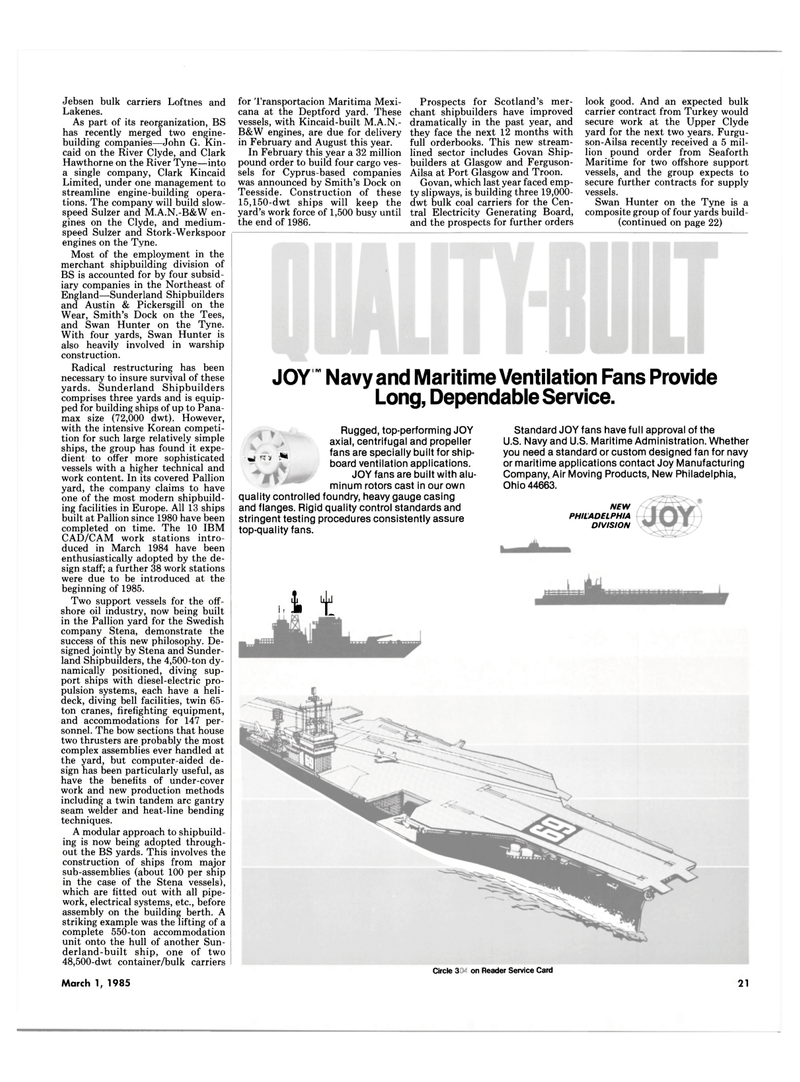
Page 19: of Maritime Reporter Magazine (March 1985)
Read this page in Pdf, Flash or Html5 edition of March 1985 Maritime Reporter Magazine
Jebsen bulk carriers Loftnes and
Lakenes.
As part of its reorganization, BS has recently merged two engine- building companies—John G. Kin- caid on the River Clyde, and Clark
Hawthorne on the River Tyne—into a single company, Clark Kincaid
Limited, under one management to streamline engine-building opera- tions. The company will build slow- speed Sulzer and M.A.N.-B&W en- gines on the Clyde, and medium- speed Sulzer and Stork-Werkspoor engines on the Tyne.
Most of the employment in the merchant shipbuilding division of
BS is accounted for by four subsid- iary companies in the Northeast of
England—Sunderland Shipbuilders and Austin & Pickersgill on the
Wear, Smith's Dock on the Tees, and Swan Hunter on the Tyne.
With four yards, Swan Hunter is also heavily involved in warship construction.
Radical restructuring has been necessary to insure survival of these yards. Sunderland Shipbuilders comprises three yards and is equip- ped for building ships of up to Pana- max size (72,000 dwt). However, with the intensive Korean competi- tion for such large relatively simple ships, the group has found it expe- dient to offer more sophisticated vessels with a higher technical and work content. In its covered Pallion yard, the company claims to have one of the most modern shipbuild- ing facilities in Europe. All 13 ships built at Pallion since 1980 have been completed on time. The 10 IBM
CAD/CAM work stations intro- duced in March 1984 have been enthusiastically adopted by the de- sign staff; a further 38 work stations were due to be introduced at the beginning of 1985.
Two support vessels for the off- shore oil industry, now being built in the Pallion yard for the Swedish company Stena, demonstrate the success of this new philosophy. De- signed jointly by Stena and Sunder- land Shipbuilders, the 4,500-ton dy- namically positioned, diving sup- port ships with diesel-electric pro- pulsion systems, each have a heli- deck, diving bell facilities, twin 65- ton cranes, firefighting equipment, and accommodations for 147 per- sonnel. The bow sections that house two thrusters are probably the most complex assemblies ever handled at the yard, but computer-aided de- sign has been particularly useful, as have the benefits of under-cover work and new production methods including a twin tandem arc gantry seam welder and heat-line bending techniques.
A modular approach to shipbuild- ing is now being adopted through- out the BS yards. This involves the construction of ships from major sub-assemblies (about 100 per ship in the case of the Stena vessels), which are fitted out with all pipe- work, electrical systems, etc., before assembly on the building berth. A striking example was the lifting of a complete 550-ton accommodation unit onto the hull of another Sun- derland-built ship, one of two 48,500-dwt container/bulk carriers
March 1, 1985 for Transportacion Maritima Mexi- cana at the Deptford yard. These vessels, with Kincaid-built M.A.N.-
B&W engines, are due for delivery in February and August this year.
In February this year a 32 million pound order to build four cargo ves- sels for Cyprus-based companies was announced by Smith's Dock on
Teesside. Construction of these 15,150-dwt ships will keep the yard's work force of 1,500 busy until the end of 1986.
Prospects for Scotland's mer- chant shipbuilders have improved dramatically in the past year, and they face the next 12 months with full orderbooks. This new stream- lined sector includes Govan Ship- builders at Glasgow and Ferguson-
Ailsa at Port Glasgow and Troon.
Govan, which last year faced emp- ty slipways, is building three 19,000- dwt bulk coal carriers for the Cen- tral Electricity Generating Board, and the prospects for further orders look good. And an expected bulk carrier contract from Turkey would secure work at the Upper Clyde yard for the next two years. Furgu- son-Ailsa recently received a 5 mil- lion pound order from Seaforth
Maritime for two offshore support vessels, and the group expects to secure further contracts for supply vessels.
Swan Hunter on the Tyne is a composite group of four yards build- continued on page 22)
JOY Navy and Maritime Ventilation Fans Provide Long, Dependable Service. w ^ It $ - JHiw
Rugged, top-performing JOY axial, centrifugal and propeller fans are specially built for ship- board ventilation applications.
JOY fans are built with alu- minum rotors cast in our own quality controlled foundry, heavy gauge casing and flanges. Rigid quality control standards and stringent testing procedures consistently assure top-quality fans. hi t
Standard JOY fans have full approval of the
U.S. Navy and U.S. Maritime Administration. Whether you need a standard or custom designed fan for navy or maritime applications contact Joy Manufacturing
Company, Air Moving Products, New Philadelphia,
Ohio 44663.
NEW
PHILADELPHIA
DIVISION
Circle 325 on Reader Service Card 21

 18
18

 20
20
